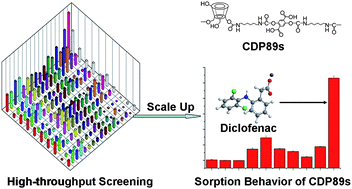A wide range of pharmaceuticals that are not completely metabolized in humans or animals are discharged into aquatic environments through a variety of sources including homes, hospitals, pharmaceutical manufactures, and animal feeding operations. The potential hazard of pharmaceuticals in waters depends on their persistence and the biological activity of their degradation by-products; some of them have been demonstrated to be harmful not only to ecosystems but also to human health. Consequently, there is a need for their detection at trace levels and efficient removal from waters. Both applications require sorbents with enhanced binding properties of the targeted pharmaceuticals.
In oder to develop materials with recognition properties, Shahgaldian used cyclodextrins (CDs) for their known ability to include hydrophobic drugs into their cavity. Nevertheless, as the range of molecules known to form inclusion complexes with CDs is fairly broad, one can expect that the produced polymers will exhibit a lack of selectivity. With this in mind, 51 water-insoluble cyclodextrin-based polyurethanes were synthesized using a high-throughput approach. The selective molecular recognition properties of the produced polyurethanes were investigated by measuring their capability to bind ten selected compounds from aqueous solutions. Interestingly, the results indicated that the influence of different CDs on the selective molecular recognition properties was fairly limited. It was demonstrated that the selective molecular recognition properties can be suitably designed and optimized by tuning their compositions and successfully applied for selective binding of targets under purely aqueous conditions.
Design and high-throughput synthesis of cyclodextrin-based polyurethanes with enhanced molecular recognition properties by Pu Xiao , Philippe F.-X. Corvini , Yves Dudal and Patrick Shahgaldian, Polym. Chem., 2013, 4, 942-946.
Julien Nicolas is a guest web-writer for Polymer Chemistry. He currently works at Univ. Paris-Sud (FR) as a CNRS researcher.











